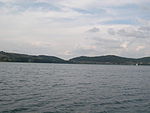Monti Sabatini

The Monti Sabatini is a geologic region in Lazio, central Italy, a remnant of intense volcanism which started ca. 600,000 years ago, mainly with pyroclastic and maar forming eruptions which continued until 100,000 years ago. The region is classified as a dormant volcanic district. The mountains are part of the Lazio's Anti-Apennines. Included between the Monti Sabatini is the Lake Bracciano, which is a volcanotectonic depression formed about 3.7 Ma, and the Lake Martignano. The sedimentary base of the Sabatini complex lies buried under 200 m (660 ft) of volcanic ash and rocks. The highest point is Monte Rocca Romana (a postcaldera stratocone), at 612 m (2,008 ft). Other mountains in the area include Monti della Tolfa, Monte Soratte, and more southwards, by the Monti Cornicolani.
Excerpt from the Wikipedia article Monti Sabatini (License: CC BY-SA 3.0, Authors, Images).Monti Sabatini
Via Monticello,
Geographical coordinates (GPS) Address Nearby Places Show on map
Geographical coordinates (GPS)
| Latitude | Longitude |
|---|---|
| N 42.166666666667 ° | E 12.25 ° |
Address
Via Monticello
Via Monticello
00069
Lazio, Italy
Open on Google Maps







